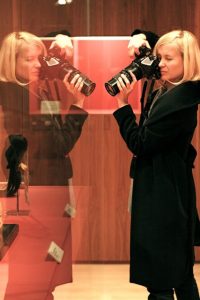"It Stuns Me Every Time": Lena Herzog On the Uncanny Powers of Photography
November 8, 2017
:quality(75)/https%3A%2F%2Fdev.lareviewofbooks.org%2Fwp-content%2Fuploads%2F2017%2F11%2FLena-Herzog-2.jpeg)
Listen to the episode
"It Stuns Me Every Time": Lena Herzog On the Uncanny Powers of Photography
00:00/00:00
"When I see an image come through in my developer, it stuns me every time. It's the stuff of magic."
Lena Herzog is a visual artist and photographer who develops thoughts and ideas as well as images. In his introduction to their conversation, Entitled Opinions host Robert Harrison suggests that her camera follows Joseph Conrad's aesthetic creed to "render the highest kind of justice to the visible world."
Harrison and Herzog discuss the cultural transition to digital photography and Herzog's penchant for a ghostly or alchemical – or even sacramental – approach to creating images. Herzog usually works with pre-digital cameras, where latent images are transformed into visible ones with emulsions in a darkroom.
The two discuss how many cultures have believed that photographs steal the soul. Have millions of digital images eroded meaning from places and people? Walter Benjamin said that photography is one of the most powerful instruments of desacralization of the world, so Harrison and Herzog discuss the over-familiarization of images of landscapes and objects, in an era when we live in oceans of images.
Herzog argues that the images capture the "inner state of being" of the photographer: “Five photographers are in a trench, they pop out, they take a picture if the same event, they pop back in. They come out with completely different images. Remember the picture of the naked girl at the napalm bombing during the Vietnam War? It's Nick Ut's very famous iconic image. On that bridge stood half a dozen photographers, including a photographer from the New York Times who was far more famous at the time. None of them produced images that stuck with us. They were shooting at the same time with the same group of Vietnamese running towards them. This is an extraordinary and fascinating aspect of photography.”
“About five billion people who have cellphones can produce fairly competent images. They're okay, but okay is not enough.”

Lena Herzog is a visual artist and photographer who lives in Los Angeles. Born in the Ural mountains of Russia, she moved to the city of St. Petersburg (then Leningrad) to study Languages and Literature at Leningrad University. She immigrated alone to the United States in 1990 and worked at Stanford University two years later as a research consultant. She then completed her BA in Philosophy at Mills College, specializing in the history and the philosophy of science and doing a comparative study of the paradigm shift theories of Thomas Kuhn and Paul Feyerabend.
In 1997, she discovered photography, and apprenticed to Italian and French printmakers, with a special interest in early and alternative photographic processes. Her work now ranges from classical documentary to the experimental and conceptual. She is married to filmmaker Werner Herzog.
Her photography has been featured and reviewed in The New York Times, The Los Angeles Times Magazine, The Paris Review, The New Yorker, Cabinet Magazine, The Believer, and Vanity Fair, among others, and she is a regular contributing artist to Harper's Magazine. She is the author of five books of photography and her work has been internationally exhibited.
Her most recent series, Lost Souls, was shown at the International Center of Photography in New York. The book by the same name was widely reviewed. Her book Strandbeest: The Dream Machine of Theo Jansen, was published by TASCHEN in the 2015.
Did you know LARB is a reader-supported nonprofit?
LARB publishes daily without a paywall as part of our mission to make rigorous, incisive, and engaging writing on every aspect of literature, culture, and the arts freely accessible to the public. Help us continue this work with your tax-deductible donation today!